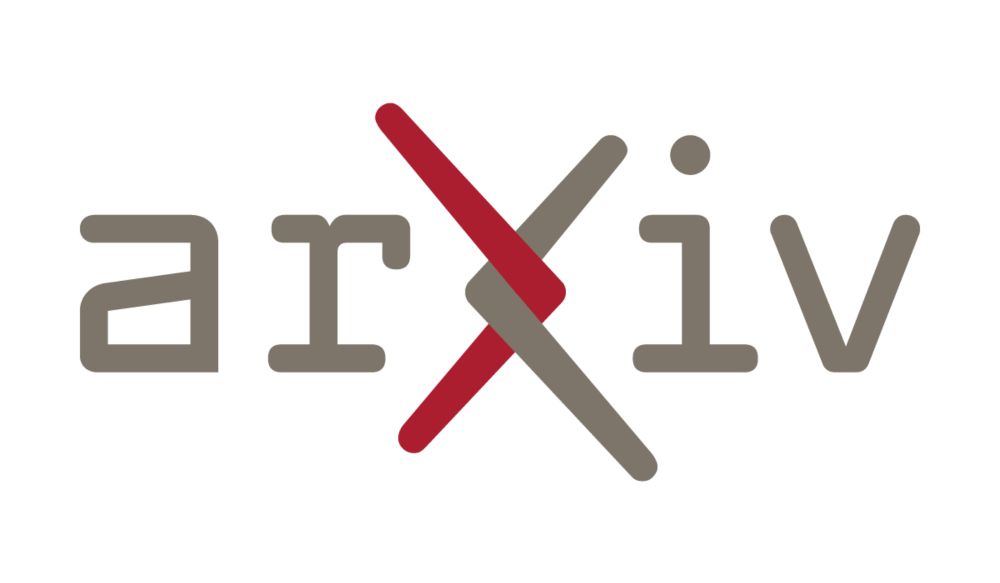🎉 Happy paper publication day! 🎉 Our third catalog of binary black hole simulations, now published in Classical and Quantum Gravity. And it's open access!
Scheel et al. 2025 Class. Quantum Grav. 42 195017
iopscience.iop.org/article/10.1...
Also on the @arxiv.bsky.social at arxiv.org/abs/2505.13378
06.10.2025 15:53 — 👍 9 🔁 6 💬 1 📌 1
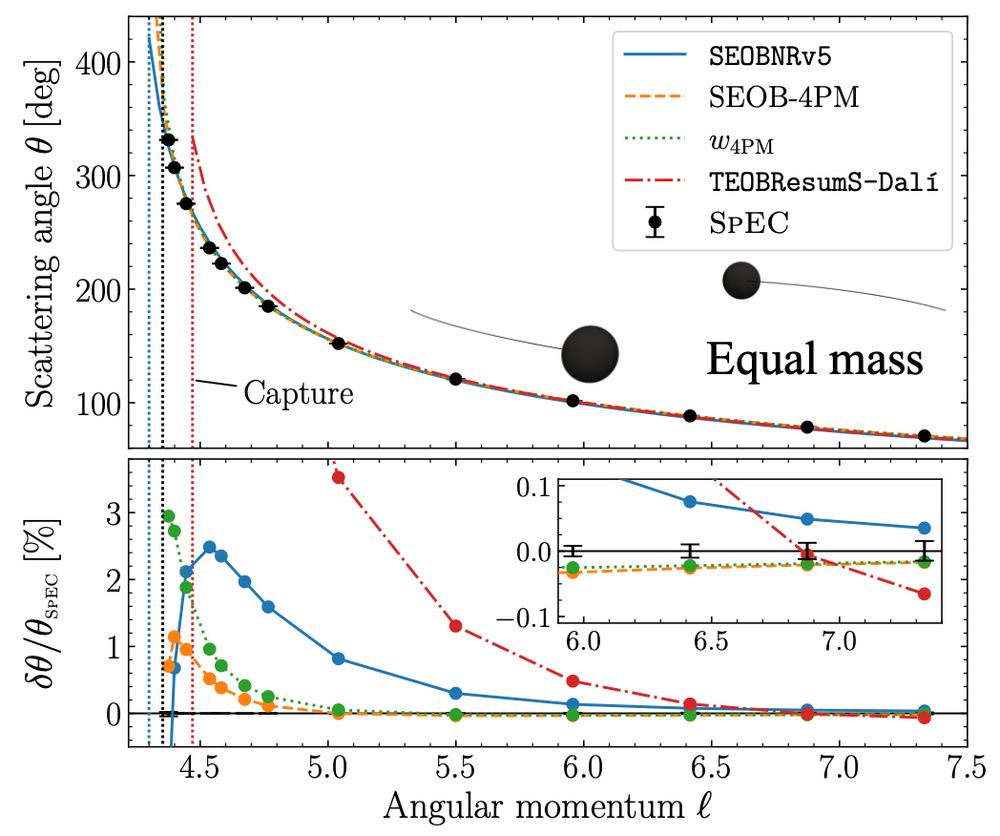
We also compared our Numerical Relativity results with predictions from effective-one-body (EOB) models. In general, the models agree with the scattering angles generated with SpEC, with the plot below showing that most models differ by less than 3% in the very strong field! (6/6)
16.07.2025 13:45 — 👍 4 🔁 1 💬 0 📌 0
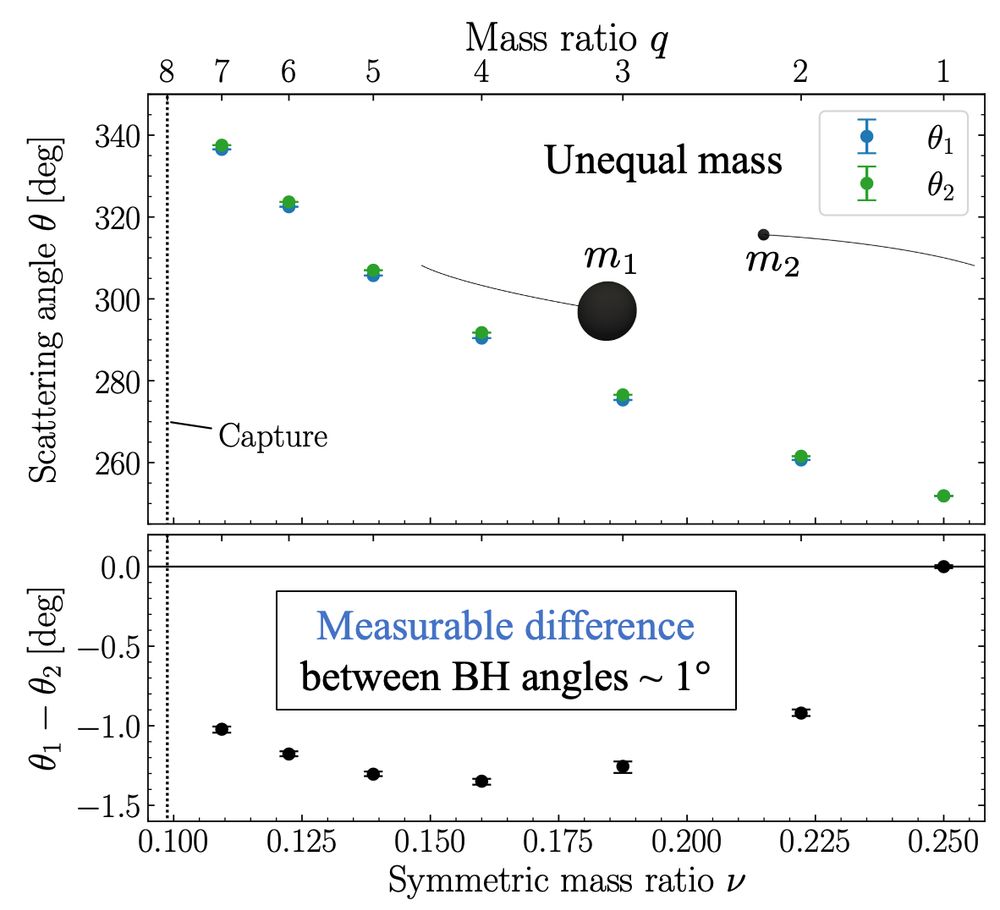
Another type of system we looked at was when the black holes have different masses. Again, we measure a difference in the scattering angle of approximately 1°. (5/6)
16.07.2025 13:45 — 👍 3 🔁 1 💬 1 📌 0
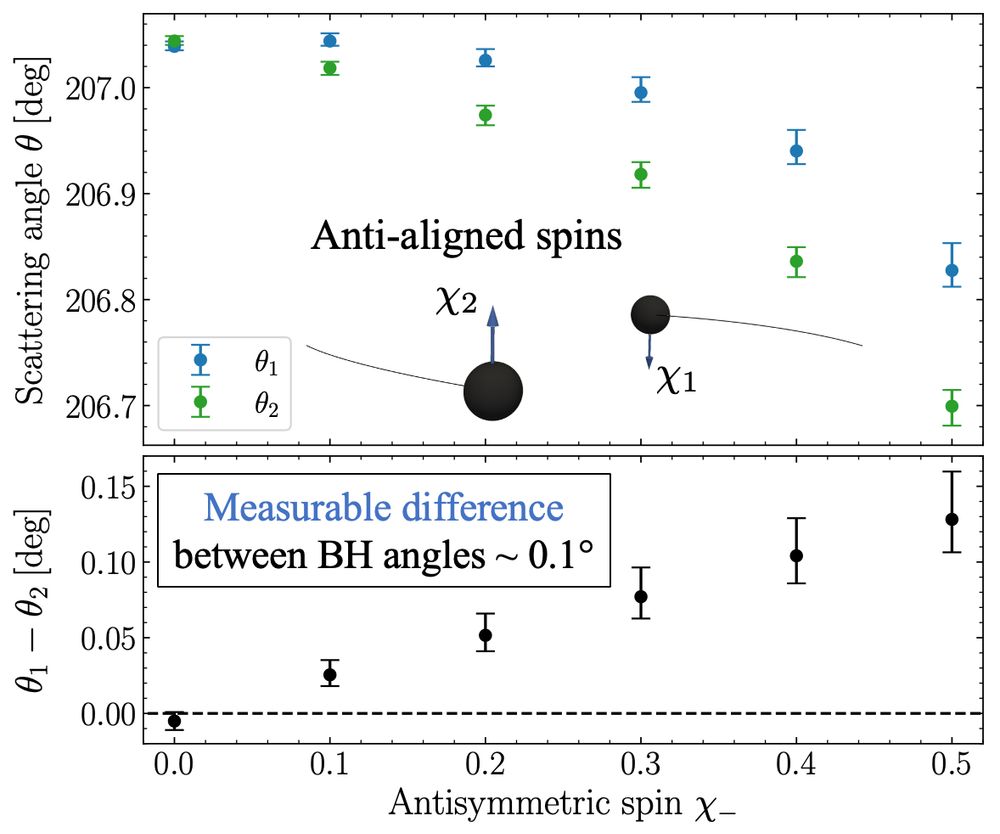
We also explored systems with broken symmetry. The first has black holes with spin in opposite directions. Here, for the first time, we measure the tiny difference in scattering angle of each black hole—only 0.1°! (4/6)
16.07.2025 13:45 — 👍 3 🔁 1 💬 1 📌 0
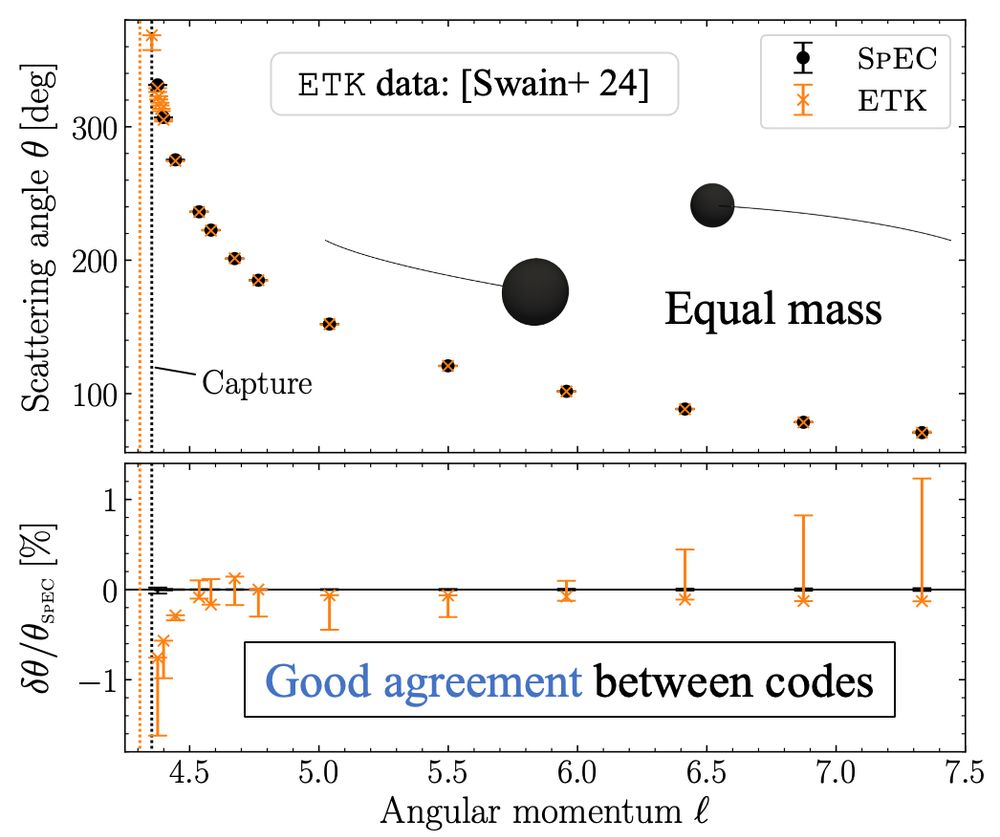
How do the SpEC results compare with those from other codes? The plot below shows a comparison between SpEC and the Einstein Toolkit (ETK) for a set of equal mass, non-spinning systems. Both codes agree to less than a percent! (3/6)
16.07.2025 13:45 — 👍 3 🔁 1 💬 1 📌 0
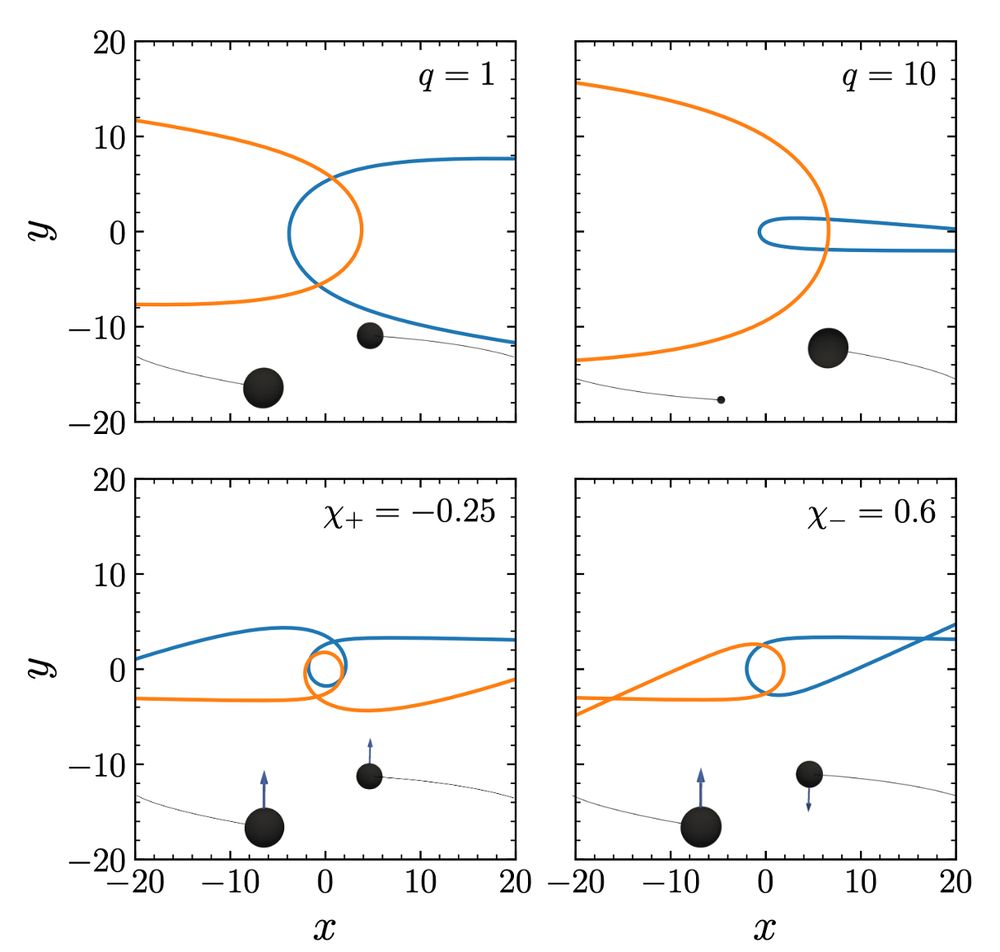
We simulated 60 unbound binary-black-hole encounters, covering systems with spinning black holes and mass ratios up to 10. A few examples of these trajectories are shown below. (2/6)
16.07.2025 13:45 — 👍 3 🔁 1 💬 1 📌 0
Bonus: here's an animation I generated showing how the sausage was made. Each frame is one commit from the paper repo.
20.05.2025 03:43 — 👍 39 🔁 6 💬 4 📌 0
I’m incredibly proud to be part of this and to have my simulations turn into the first publicly available scattering and dynamical capture waveforms!
Below is a plot I made for the Einstein Toolkit Blue Book (arXiv:2503.12263) showing the waveforms SXS:BBH:3999 (scatter) and SXS:BBH:4000 (capture).
21.05.2025 05:43 — 👍 11 🔁 6 💬 0 📌 1
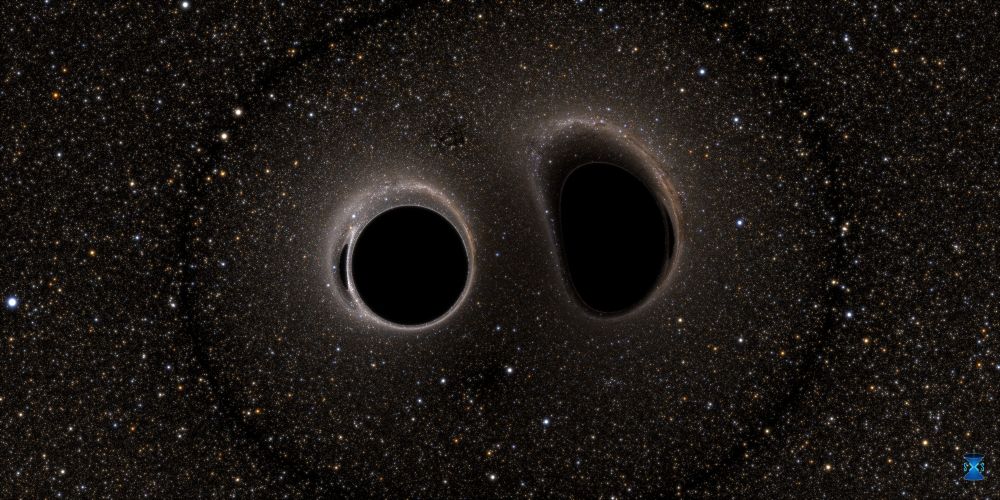
Happy #BlackHoleWeek! To celebrate, we’re releasing the highest-resolution ray-traced still from one of our simulations to date. This skeet has a low res preview. To zoom into the full 43,200 × 21,600 pixel rendering, head to www.black-holes.org/2025/05/07/B...
🧪⚛️🔭
07.05.2025 17:55 — 👍 62 🔁 20 💬 3 📌 2
When your work Secret Santa gift link to your research
11.12.2024 17:58 — 👍 3 🔁 0 💬 0 📌 0
Black holes do have mass! In fact according to the no hair theorem they are completely described by just their mass and their angular momentum.
No special analytic solutions I’m afraid. You can get approximate analytic solutions (e.g. when they’re slowly moving and far away) but nothing generic.
09.12.2024 16:36 — 👍 1 🔁 0 💬 0 📌 0
Yes of course!
Essentially, in Newtonian gravity when we have two bodies we know how to solve it exactly. In General Relativity, this isn’t the case as it’s too complex. One way we can find solutions is to solve the equations by putting them on a supercomputer for a month or two. That’s what I do!
08.12.2024 15:31 — 👍 3 🔁 0 💬 2 📌 0
For more info about my research, publications, or talks, visit my website: oliverlong.info. I’m also always happy to connect or chat!
08.12.2024 10:39 — 👍 3 🔁 0 💬 0 📌 0
(6/7) Outside of physics, I’m an avid climber with over 300 outdoor climbs across four countries (trad, sport, and bouldering). Here are my stats if you’re curious:
08.12.2024 10:39 — 👍 3 🔁 1 💬 0 📌 1
(5/7) I’m part of the effort to get the space-based Laser Interferometer Space Antenna (LISA) off the ground as an active LISA Consortium member. I’m also a former member of the LIGO collaboration.
Image courtesy of European Space Agency (ESA).
08.12.2024 10:38 — 👍 2 🔁 0 💬 0 📌 1
(4/7) Through my work on self-force, I became a contributor to the KerrGeodesics package of the Black Hole Perturbation Toolkit (BHPT). I am also a contributor to the Spectral Einstein Code (SpEC) of the SXS collaboration.
08.12.2024 10:36 — 👍 4 🔁 0 💬 0 📌 1
(3/7) In 2022, I started my postdoc at the Max Planck Institute for Gravitational Physics (AEI) in Potsdam, Germany. Here, I extended my work to include black hole scattering with comparable masses using Numerical Relativity as part of the @sxs-collaboration.bsky.social.
08.12.2024 10:35 — 👍 8 🔁 2 💬 0 📌 1
(2/7) I earned my MPhys in Physics from the University of Manchester (2018) and a PhD in Mathematical Sciences from the University of Southampton (2022). My PhD focused on using black hole perturbation theory to model small black holes scattering off supermassive black holes.
08.12.2024 10:33 — 👍 5 🔁 1 💬 0 📌 1
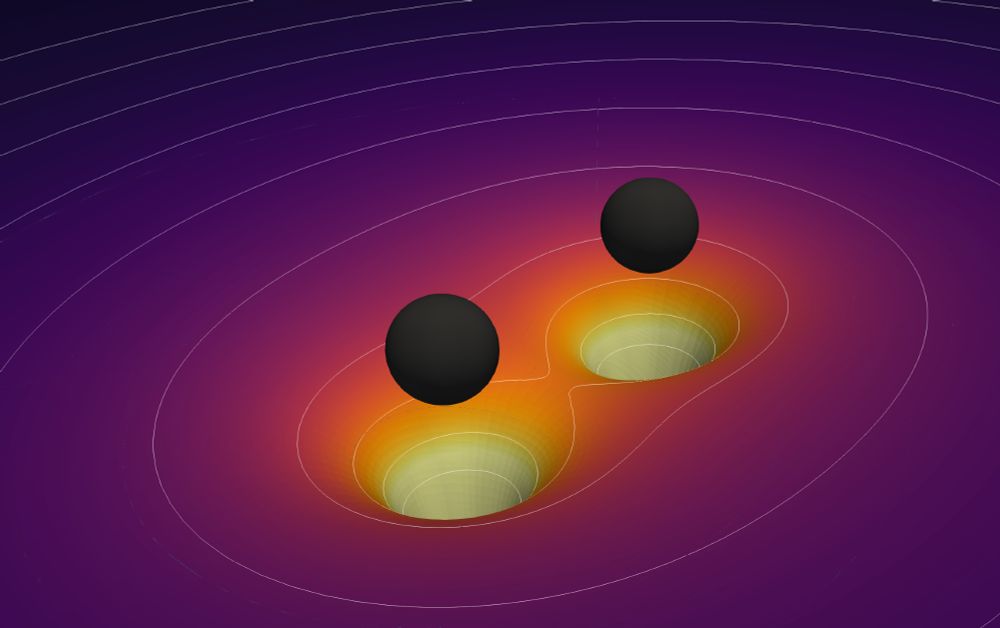
Artist’s impression of the horizons and curvature of a binary black hole system. Generated using Paraview.
(1/7) As I’m new here I thought I should introduce myself!
My name is Olly Long and I am a researcher working on modelling the binary black hole problem in General Relativity.
08.12.2024 10:32 — 👍 34 🔁 5 💬 2 📌 1
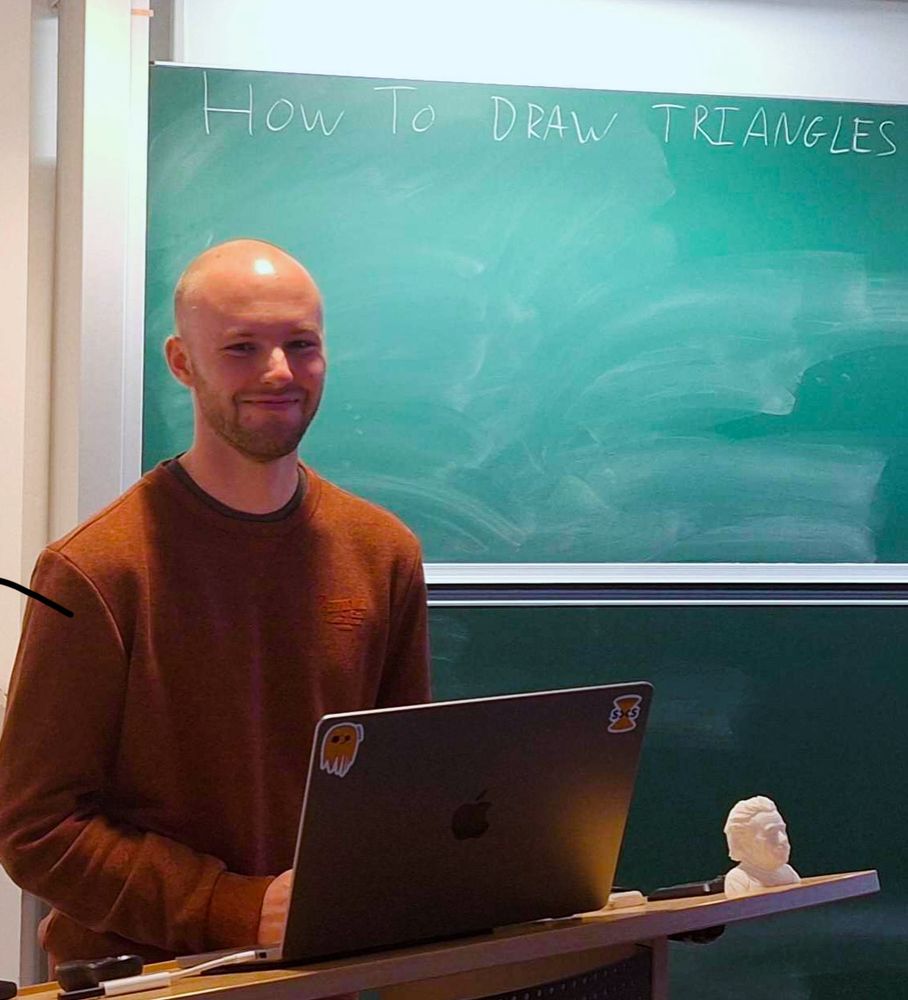
Sometimes you have to go back to the basics
05.12.2024 18:55 — 👍 6 🔁 0 💬 0 📌 1
Here is a visualisation of one of my Numerical Relativity simulations with @sxs-collaboration.bsky.social’s Spectral Einstein Code (SpEC).
The initially unbound system loses enough energy at closest approach to become bound leading to a merger. It’s one of the coolest looking simulations I’ve done!
04.12.2024 05:34 — 👍 13 🔁 3 💬 0 📌 0
Get ready for a new era in astronomy and astrophysics with Rubin Observatory!
Para español siga a Instagram: http://instagram.com/rubin_observatory
We throb knowledge, we pulse excellence. Ranked No.1 in the UK for Canteen Facilities (CEF, 2024). Vice-Chancellor Vince Chancelier (He/VC). Parody.
Astrophysicist. Currently working on my second PhD on gravitational waves from black holes, at the Gravity Exploration Institute, Cardiff University.
They/any 🏳️🌈
Gravitational-wave astronomer. Author, physicist, philosopher. Revealer of truths, exposer of lies. Exemplar of humanity. Also rather modest. https://fictionalaether.substack.com/
Astrophysicist @monashastro.bsky.social | Previously @ Northwestern & UMN | తెలుగు | Gravitational waves | @LIGO | LISA
Decarbonization now ✊🏽
All opinions my own and do not represent past or present employers.
orcid : https://orcid.org/0000-0001-7852-7484
Astrophysicist. Associate Professor at Stony Brook University, Gravitational Wave Astronomy Group Leader at Flatiron Institute's Center for Computational Astrophysics.
ISFJ,Blackfoot,Scottish, Washington, PNW,
Backpacker,Salsa Dancer,Traveler,LIGO, Gravitational Waves
https://linktr.ee/corey_m_gray
CITA Postdoctoral Fellow: LIGO and gravitational waves. (Ex-?)theatre artist. @alsogoesbyV on Twitter.
Website: adivijaykumar.github.io
GRAPPA is a centre of excellence of the University of Amsterdam, focussing on Gravitation and Astroparticle Physics.
A NSF-funded Physics Frontiers Center using pulsars to search for low-frequency gravitational waves! They/Them/Theirs
Astronomer, driving The Dish📡 to study pulsars in my PhD. Also, founded SpaceAustralia.com. Also, love a bit of astrophotography. Also, do everything with my little mate, Max. Also, Ultra-Gay. He/Him.
CUNY Astro prof, AMNH research assoc, runner, astronomer, crafter, camper, gardener, mom, all opinions completely my own (she/her)
Professor of astrophysics at UNC, studying colliding black holes, swarming stars, and other things that go bump in the night. Big fan of transit, biking, climbing, Durham NC, he/him
dynamics.unc.edu
Professor of Theoretical Physics at King’s College London doing cosmology, gravity, astrophysics and string theory. GRTL Collaboration and UK Numerical Relativity. Views my own. Penang-lang.
https://nms.kcl.ac.uk/eugene.lim
🕵️ Investigator of ripples in space-time (astrophysicist)
✨ Postdoc fellow at Northwestern Uni + Adler Planetarium 🇺🇸
linktr.ee/astronerdika | 🇦🇺🇱🇰(she/her)
Theoretical Astrophysicist at the University of Bath, UK. Spends time thinking about Mathematical Physics, Neutron Stars, Black Holes, Planets and Disks, Board Games, Crafting, Leather Working, Cooking, and other stochastically determined hobbies.
Astrophysicist, gravitational waves and multi-messenger astronomy, working mother, European + 🌍 @ ❤️, British + born in London UK, professor at the University of Potsdam, DESY & German Centre for Astrophysics (DZA); also @GRAPPAcentre at Univ. of Amsterdam.
NASA Einstein Fellow at Northwestern studying gravitational waves with LIGO | previously PhD at MIT | violinist and cat lover





